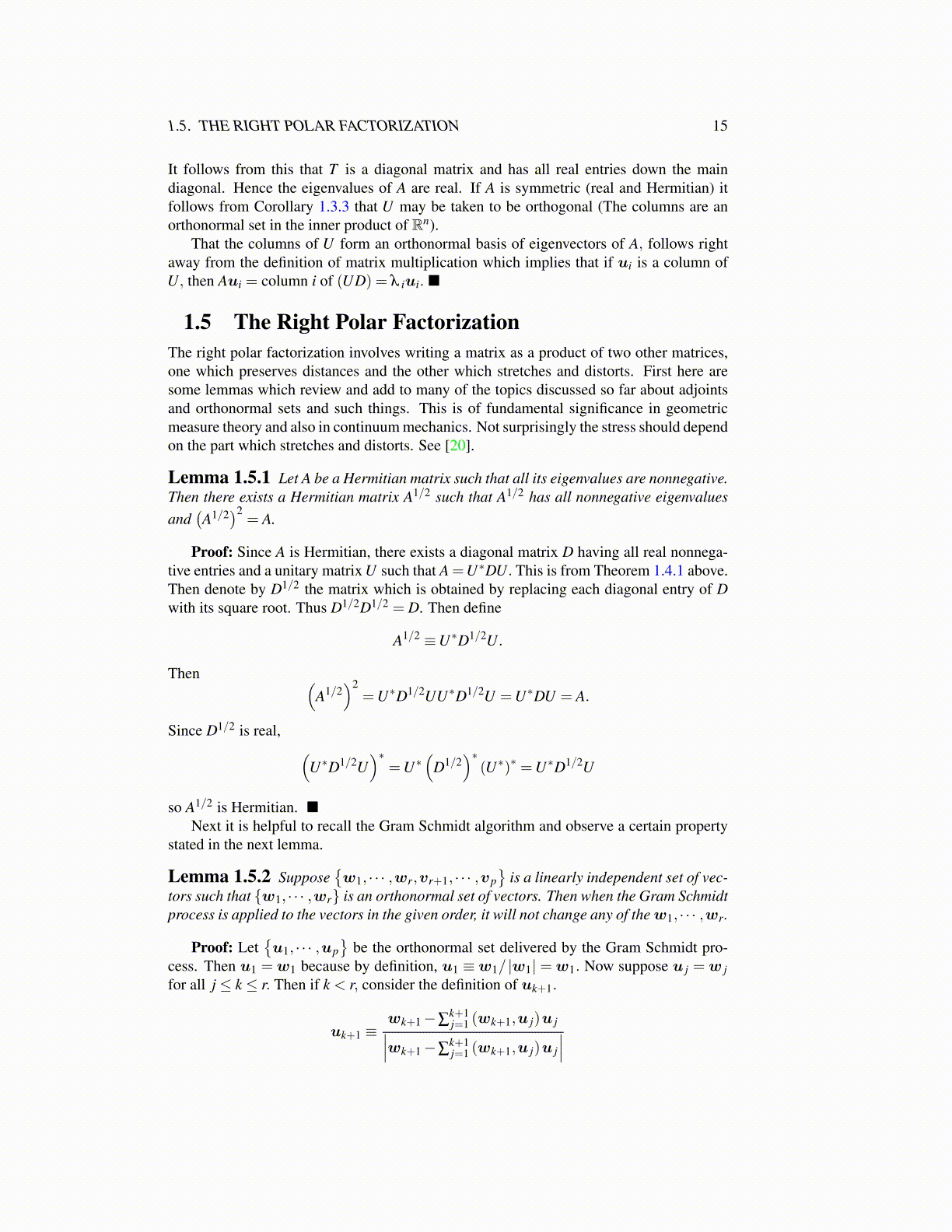
1.5. THE RIGHT POLAR FACTORIZATION 15
It follows from this that T is a diagonal matrix and has all real entries down the maindiagonal. Hence the eigenvalues of A are real. If A is symmetric (real and Hermitian) itfollows from Corollary 1.3.3 that U may be taken to be orthogonal (The columns are anorthonormal set in the inner product of Rn).
That the columns of U form an orthonormal basis of eigenvectors of A, follows rightaway from the definition of matrix multiplication which implies that if ui is a column ofU, then Aui = column i of (UD) = λ iui. ■
1.5 The Right Polar FactorizationThe right polar factorization involves writing a matrix as a product of two other matrices,one which preserves distances and the other which stretches and distorts. First here aresome lemmas which review and add to many of the topics discussed so far about adjointsand orthonormal sets and such things. This is of fundamental significance in geometricmeasure theory and also in continuum mechanics. Not surprisingly the stress should dependon the part which stretches and distorts. See [20].
Lemma 1.5.1 Let A be a Hermitian matrix such that all its eigenvalues are nonnegative.Then there exists a Hermitian matrix A1/2 such that A1/2 has all nonnegative eigenvaluesand
(A1/2
)2= A.
Proof: Since A is Hermitian, there exists a diagonal matrix D having all real nonnega-tive entries and a unitary matrix U such that A =U∗DU. This is from Theorem 1.4.1 above.Then denote by D1/2 the matrix which is obtained by replacing each diagonal entry of Dwith its square root. Thus D1/2D1/2 = D. Then define
A1/2 ≡U∗D1/2U.
Then (A1/2
)2=U∗D1/2UU∗D1/2U =U∗DU = A.
Since D1/2 is real, (U∗D1/2U
)∗=U∗
(D1/2
)∗(U∗)∗ =U∗D1/2U
so A1/2 is Hermitian. ■Next it is helpful to recall the Gram Schmidt algorithm and observe a certain property
stated in the next lemma.
Lemma 1.5.2 Suppose{w1, · · · ,wr,vr+1, · · · ,vp
}is a linearly independent set of vec-
tors such that {w1, · · · ,wr} is an orthonormal set of vectors. Then when the Gram Schmidtprocess is applied to the vectors in the given order, it will not change any of the w1, · · · ,wr.
Proof: Let{u1, · · · ,up
}be the orthonormal set delivered by the Gram Schmidt pro-
cess. Then u1 =w1 because by definition, u1 ≡w1/ |w1| =w1. Now suppose u j =w jfor all j ≤ k ≤ r. Then if k < r, consider the definition of uk+1.
uk+1 ≡wk+1−∑
k+1j=1 (wk+1,u j)u j∣∣∣wk+1−∑k+1j=1 (wk+1,u j)u j
∣∣∣